








There is a clear vein of Pop Culture in KAWS’ art, most noticeably in his cast of cartoonish characters and motifs, including his bestknown characters with crossed out eyes.
Brian Donnelly, known professionally as KAWS, is a celebrated artist and designer known for his signature limited-edition toys, paintings, sculptures and prints using a variety of media.
KAWS was born in Jersey City in 1974 and graduated from the School of Visual Arts in New York with a BFA. He became interested in graffiti at an early age, and honed his skills in the early 1990s, graffiti-bombing trains, walls and billboards in Lower Manhattan before moving on to subverting images on billboards, bus stops and phone booths with his characters such as ‘The Companion’, ‘Bendy’ and ‘The Accomplice’. As he gained street accreditation, these graffiti advertisements became increasingly sought after by the public, and he travelled extensively to work in Paris, London, Germany and Japan. He went on to work as a freelance artist for Disney, creating animated backgrounds.
In the late 1990s, KAWS began to design and produce limitededition vinyl toys which were an immediate hit internationally, particularly in Japan. He has also designed clothing for popular brands such as Vans, Uniqlo, and Nike, as well as Supreme Comme des Garçons and Hennessy - everything from skateboards to perfume bottles, applying his distinctive signature style.
“I guess my goal has been just to figure out how to get through life making stuff.”
KAWS FINAL DAYS, 2017
Bronze 24 x 22 x 17 cm | 10 x 9 x 7 inches Edition of 25


Solid Wood (Dark Ebony)
253 x 115 x 95 cm | 100 x 45 x 37 inches
Edition of 3
KAWS

BFF SEEING (LAMP), 2018
Alloy, Ceramic, LED light and Mixed Media 37 x 18 x 19 cm | 15 x 7 x 7 inches
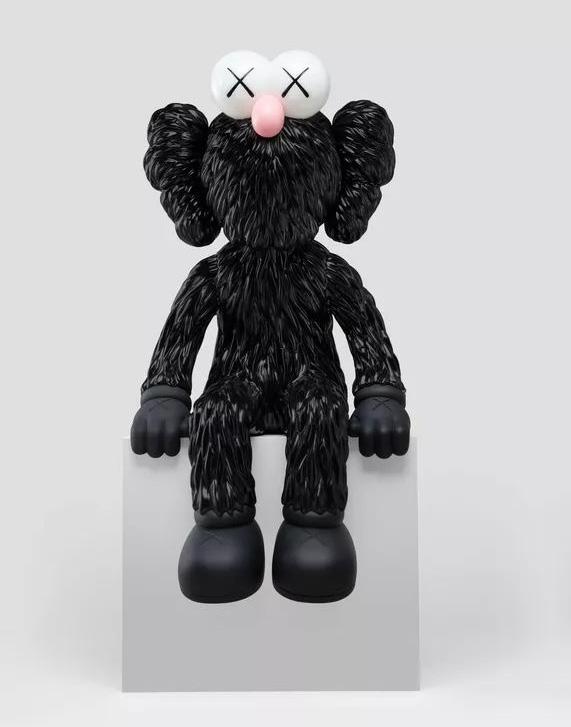

“People say graffiti is ugly, irresponsible and childish. But that’s only if it’s done properly”.
Banksy first started creating street art in the early 1990’s under the pseudonym ‘Robin Banx’. Quickly dropping this alias in favour of the shorter and more memorable moniker, ‘Banksy’, the artist began his career close to home in Bristol, England.
Immersing himself in graffiti culture, he started spray-painting walls across the Southwest. With graffiti being considered vandalism as opposed to art at the time, Banksy was soon subject to close encounters with the law and at the age of 18, was nearly apprehended by police whilst spray-painting a train in Bristol. To avoid being caught in the future, Banksy knew that he had to devise a quicker method of creating his art. Stencilling presented a practical solution for creating and replicating his work quickly, and soon his bold and iconic stencils defined his practice. On the topic of his method, Banksy reportedly said: “as soon as I cut my first stencil I could feel the power there. I also like the political edge. All graffiti is low-level dissent, but stencils have an extra history. They’ve been used to start revolutions and to stop wars”.
By 1999, Banksy had moved to London and was beginning to garner national attention. The unknown street artist was making waves, and comparisons to the graffiti greats Jean-Michel Basquiat and Keith Haring soon began to circulate.






BANKSY BRITANNIA CCTV, 2009
Spray Paint on Metal Mesh 130 x 99 cm | 51 x 39 inches



Hand Painted Watercolour on Screen Print


56 x 76 cm | 22 x 30 inches
Unique Signed Edition Published by Pictures on Walls


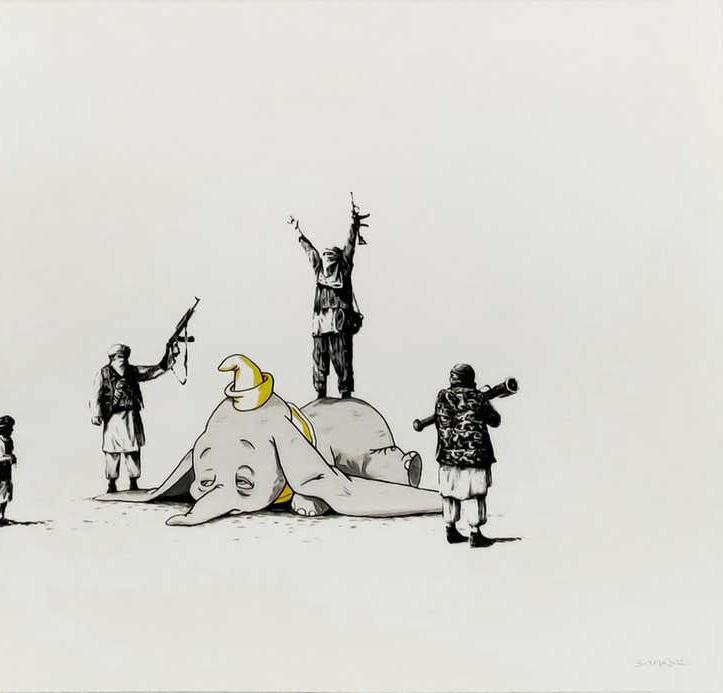





Spray Paint on Canvas
30 x 30 cm | 12 x 12 inches (each)
Edition of 25

Tagged ‘BANKSY’ (on the overlap)
Signed, dated and numbered ‘BANKSY 5/9/05‘ (on the stretcher)


BANKSY PLASTER HEART, 2012

Spraypaint on Board 97 x 86 cm | 38 x 34 inches



“Art is what you can get away with”.
Andy Warhol’s works span a variety of media including painting, silkscreening, photography, film, and sculpture, exploring the relationship between artistic expression, celebrity culture and advertising, all of which flourished in 1960s New York.
Warhol is one of the most iconic artists in the history of experimental art, pioneering the Pop Art movement and commercialising the genre in ways that had never been seen before. Combining avant-garde concepts with highlycommercial techniques, he embraced consumerism and its aesthetic at a time when most of his contemporaries were rebelling against it, and his works were received with mixed reaction. His first exhibition of 32 Campbell’s Soup cans in 1962 was panned at the time by attending art critics but later gained international acclaim. Warhol relished the notoriety: “Art is what you can get away with”, he famously declared.
His works span a variety of media including painting, silkscreening, photography, film, and sculpture, exploring the relationship between artistic expression, celebrity culture and advertising, all of which flourished in 1960s New York.








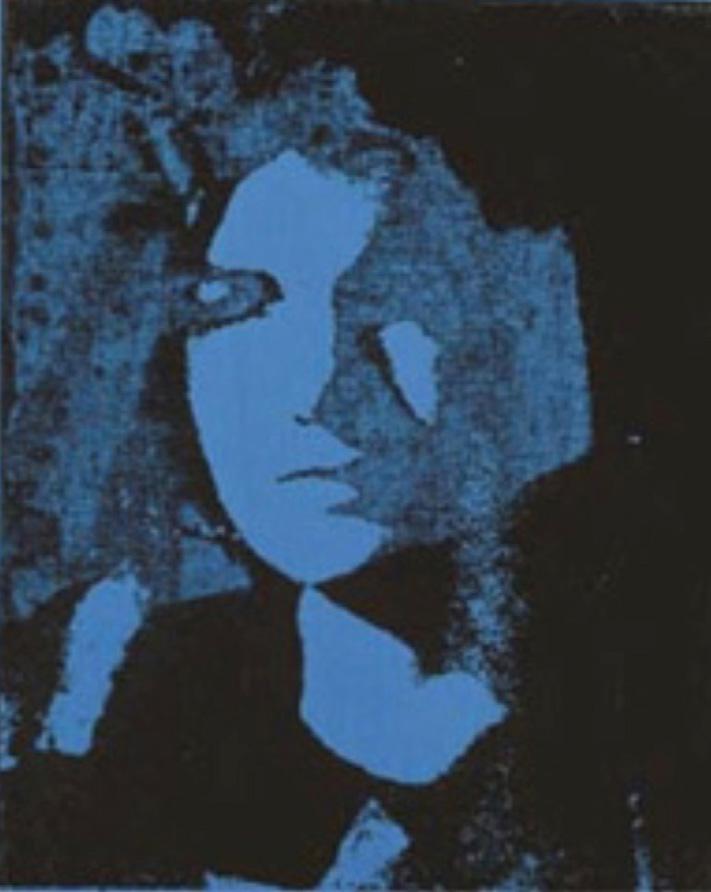

Acrylic and Silkscreen on Canvas 51 x 41 cm | 20 x 16 inches

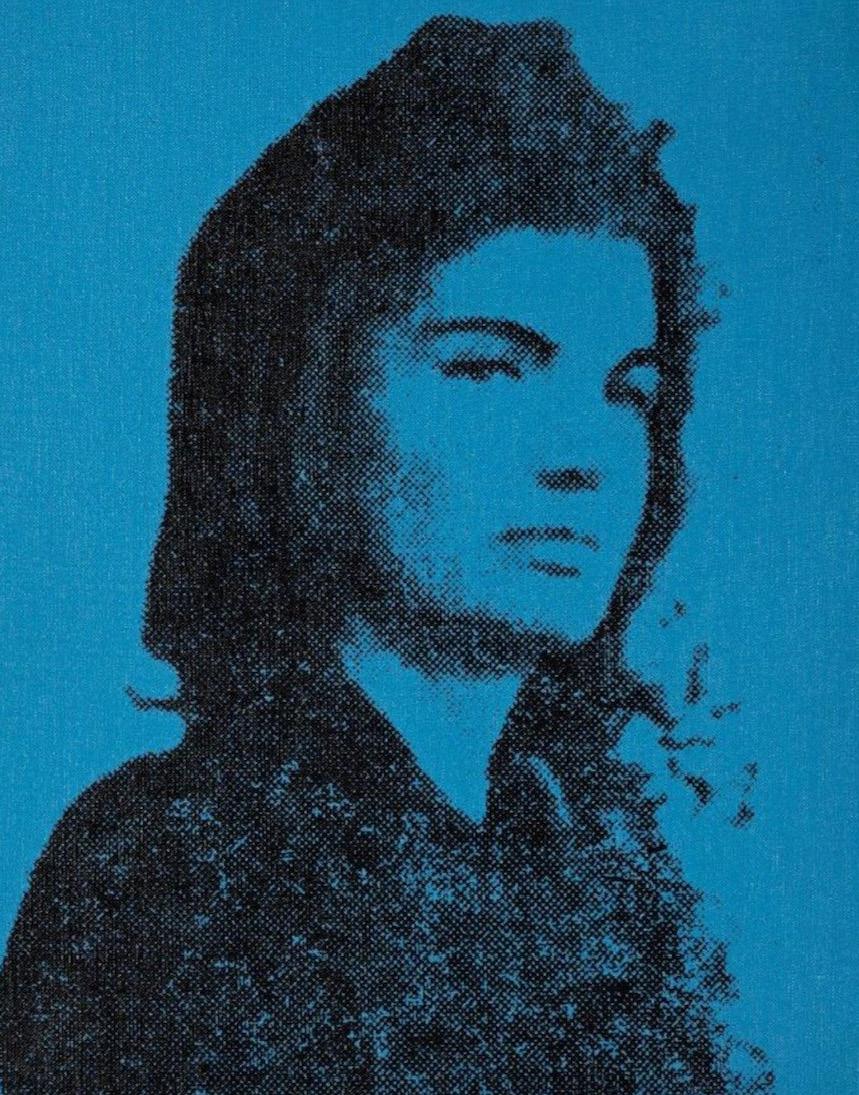
Acrylic and Silkscreen on Canvas 51 x 41 cm | 20 x 16 inches

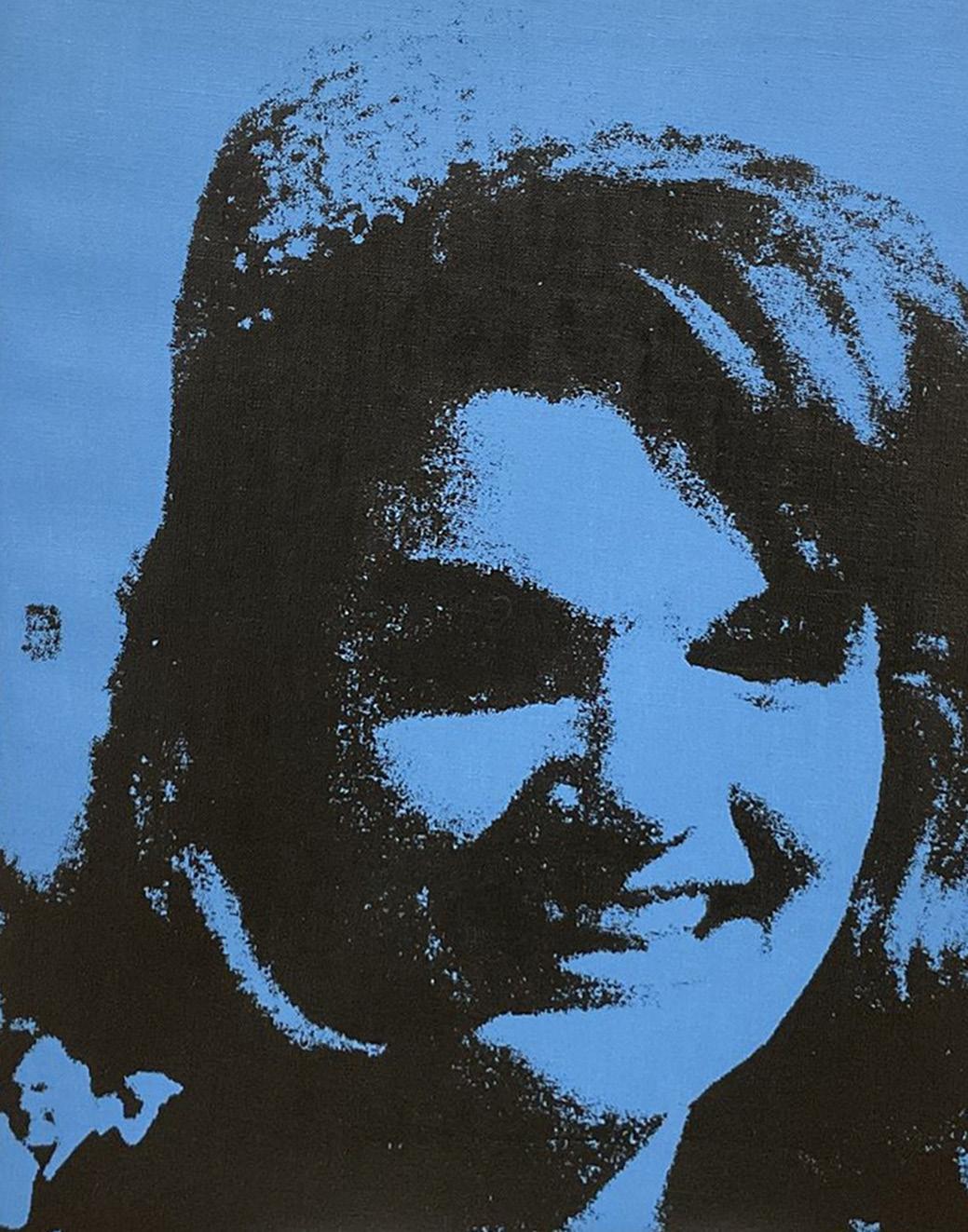

Acrylic and Silkscreen on Canvas 51 x 41 cm | 20 x 16 inches



Acrylic and Silkscreen on Canvas 51 x 41 cm | 20 x 16 inches


Screenprint on Lenox Museum Board 97x 97 cm | 38 x 38 inches

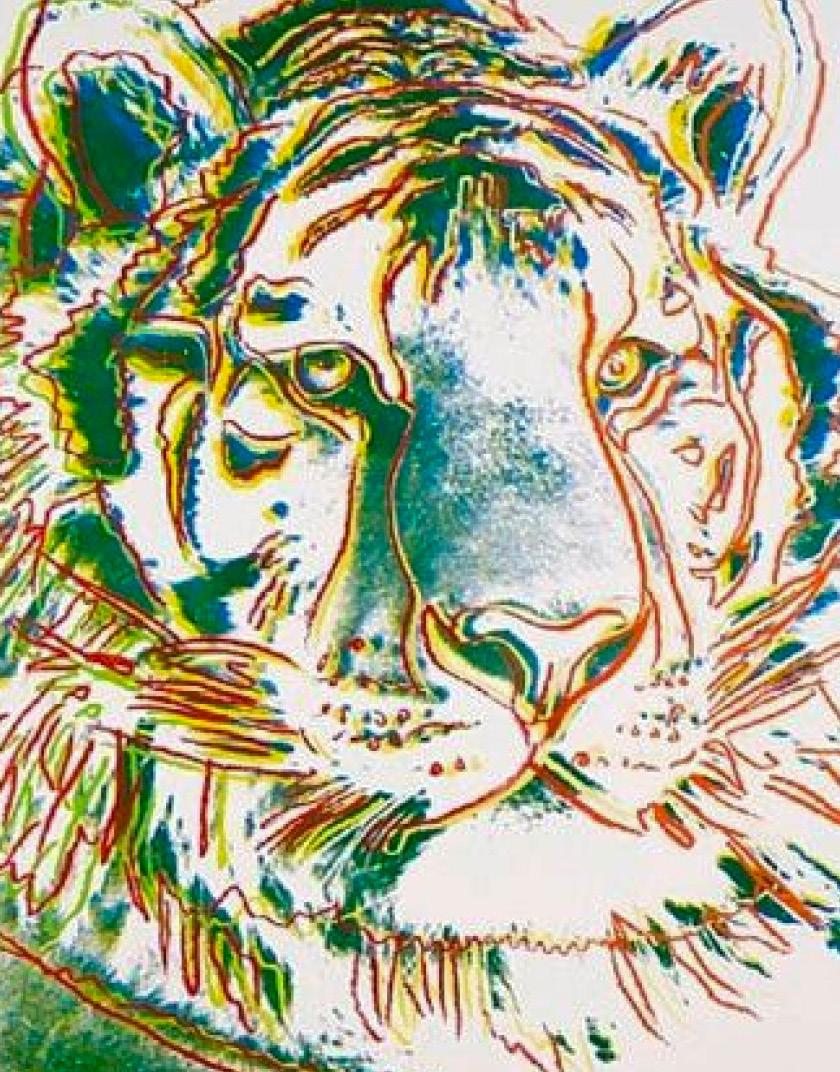

Born in Yorkshire in 1964, Miller graduated from Chelsea School of Art in 1988 with both a Bachelor’s and Master’s degree. Following his time at university, Miller began travelling the world, living in London, New York, Berlin and Paris. In 1987, Miller had his first ever solo exhibition at the Diorama in London. He then went on to New York where he would exhibit as a solo artist at Prisunic Gallery in 1990 and 1991. Widening his French audience, with thanks to his shows at Prisunic Gallery, Miller then moved to Paris where he had three more solo exhibitions over the next five years. During this period, Miller also spent a year living in Berlin, which is where he embarked upon his writing career.
Although establishing himself as an artist, Miller first won critical acclaim as a writer, with his debut novel, Slow Down Arthur, Stick to Thirty, being published in 2000. Later that year, he also published At First I was Afraid, I was Petrified - a visually led book that is considered short study of Obsessive Compulsive Disorder. The work’s sardonic title, borrowed from the Gloria Gaynor song, is echoed in the title of one of Miller’s later artworks, with puns and wordplay being the basis of many of the artist’s work.
In 2001, Miller produced the first of his iconic series of Penguin Book covers and was immediately struck by the visceral nostalgia of it. Consequently, Miller has spent the past two decades developing his satirical take on the books, marrying his love for words and art.
‘Brevity is no strength of mine’
HARLAND MILLER LOVE SAVES THE DAY, 2021

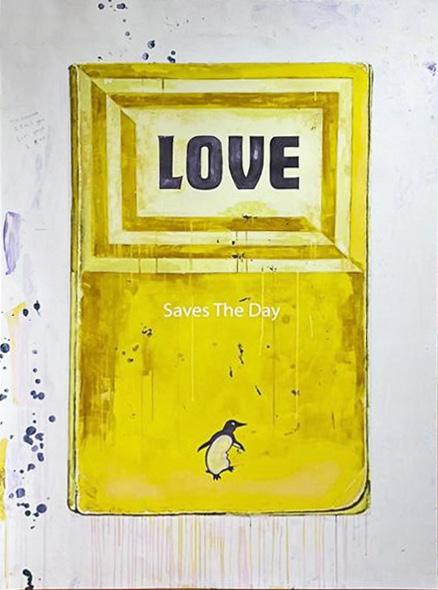
Mixed Media on Paper
146 x 105 cm | 57 x 41 inches

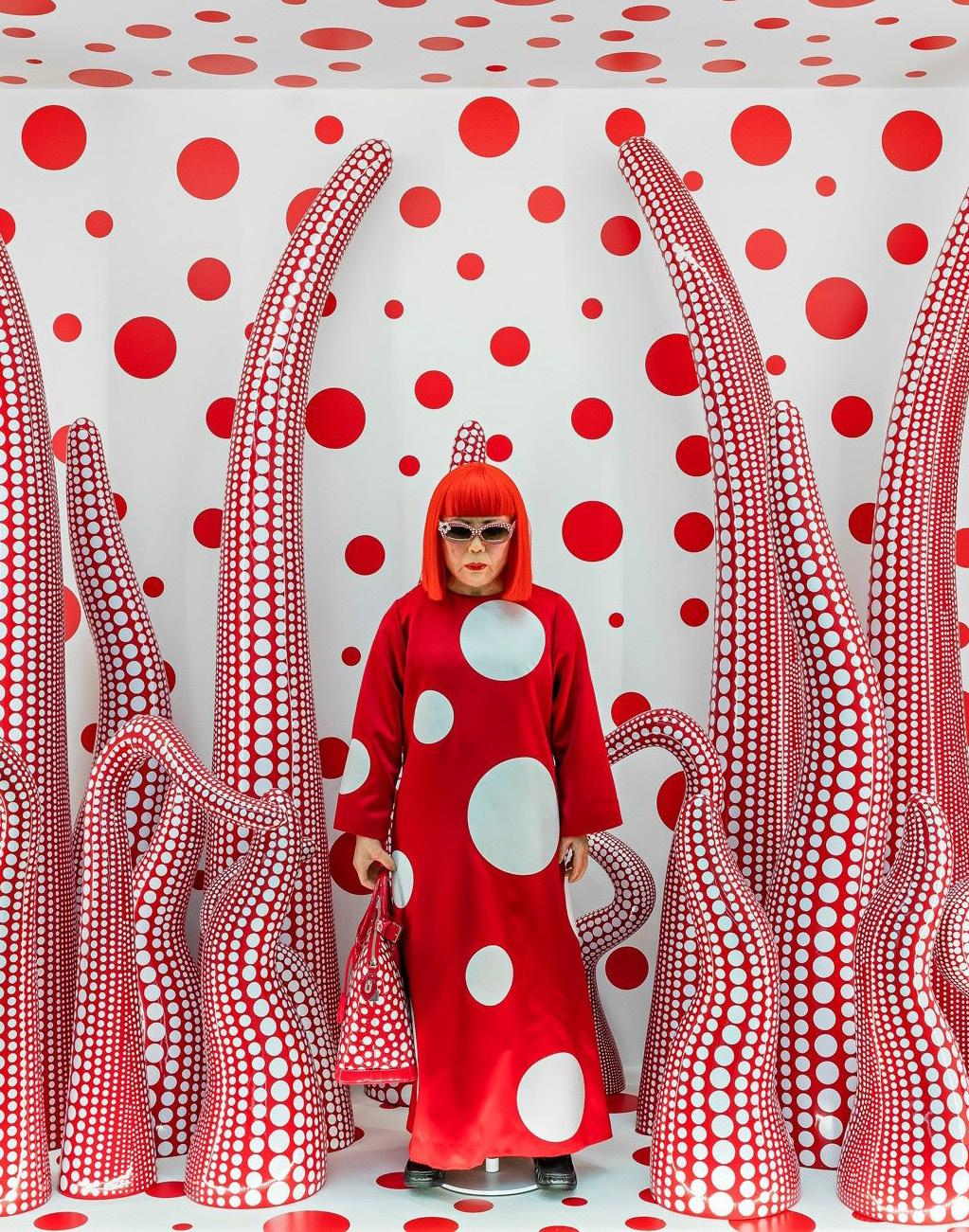
“With just one polka dot, nothing can be achieved”.
Kusama was born in Matsumoto City, Japan in 1929. From a young age, the artist grappled with difficult trauma and mental health issues which she channelled into her artwork as a form of relief.
Moving from Japan to New York City in 1957 marked a watershed moment in Kusama’s life and wider career. Much of her early work involved provocative, political performances featuring public nudity and other illegal elements, therefore the freedom of the United States allowed her full creative expression. In the late 1950s, she started creating her iconic Infinity Nets (1959 - present) series, including paintings and sculptures painted with repeating patterns such as polka dots, echoing Kusama’s definition of herself as an ‘obsessional artist’. The individual works gradually developed into large-scale installations filling up entire rooms such as in her Infinity Mirror Room (1965), incorporating mirrors to enhance the immersive effect of her artworks. Other notable works from this period include White No.28 (1960), NO. RED B (1960) and Interminable net #3 (1959). These are amongst Kusama’s most desirable artworks, engaging with themes around the subconscious, fixation and selfreflection, blurring the lines between illusion and reality.

THE END OF UNIVERSE, 2012
Acrylic on Canvas 162 x 130 cm | 64 x 51 inches


Born in 1957, George Condo grew up in Concord, New Hampshire. At the age of 18, Condo attended the University of Massachusetts in Lowell, where he studied art history and music theory. After just two years of college, Condo left and started working in a silkscreen shop in Boston. Whilst there, the budding artist also joined a band called The Girls, which led him to meeting the renowned street artist, Jean-Michel Basquiat. Basquiat encouraged Condo to pursue his artistic career and consequently, Condo moved to New York.
Between 1981 and 1983 Condo remained in New York, working in Andy Warhol’s factory applying gold to the pop artist’s Myths series. During this time, Condo’s first public exhibitions were held in the East Village galleries. Whilst not a solo exhibition, Condo would move to Los Angeles in 1983 to host his first solo show in the Ulrike Kantor Gallery, followed by another at Germany’s Monika Sprueth Gallery in 1984; a show that marked his European debut.
Following these events, Condo returned to New York where he had two solo exhibitions with Pat Hearn Gallery and Barbara Gladstone Gallery. This signalled a turning point in Condo’s career, as since then, he has gone on to host exhibitions all over the world. From the Musée Maillol in Paris to the Solomon R. Guggenheim Museum in New York, Condo continues to exhibit at the world’s finest art institutions.
‘I describe what I do as psychological Cubism’


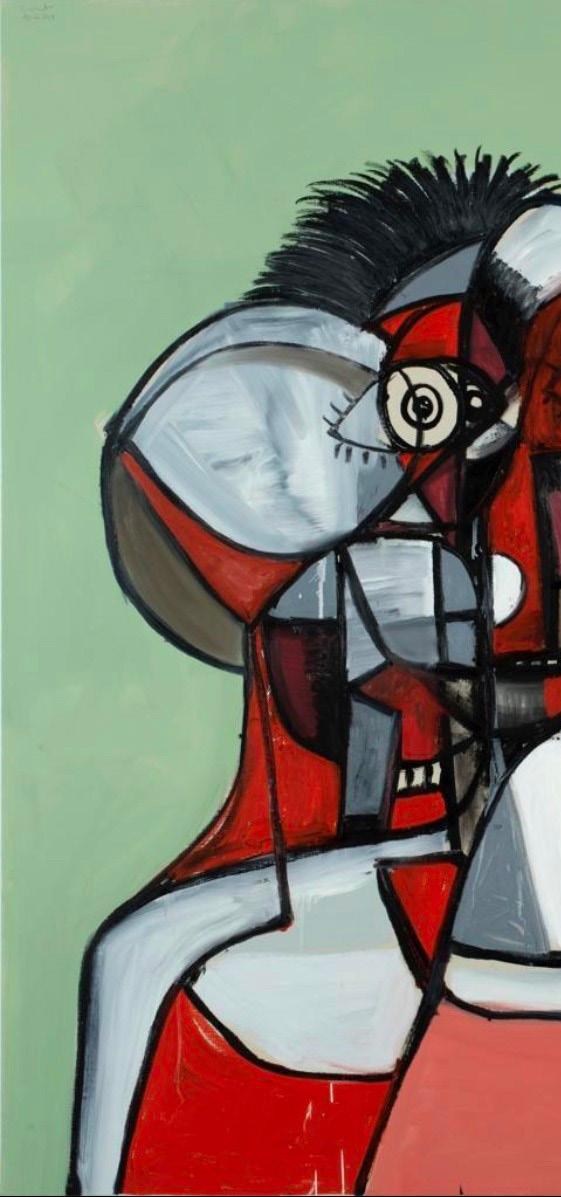






“I like to reimagine the genre of still life, bringing a fresh new style to representing the beauty of nature.”
Born and raised in Evansville, Indiana, Andrew Cooper – now more widely known as Cooper – is an American visual artist. Passionate about art from a young age, the artist created drawings in sketchbooks and at seven years old, wrote a message that would later prove prophetic in his diary, which read “I want to be an artist when I grow up”. As he grew older, the artist pursued sport, temporarily pausing his creative pursuits. Yet, on enrolling at Ball State University in Indiana, his passion for art continued to flourish, and as a result, he decided to go to art school to study graphic design.
Although primarily focussed on graphic design, Cooper took extra classes in painting and woodwork, mastering all mediums. Two weeks after graduating in 2016, the artist moved to Miami to working at a record label as a graphic designer. After staying there for a year, Cooper moved to Los Angeles to pursue his career as a freelance artist, perfecting his painting technique.
In 2019, the artist moved back to Evansville, Indiana to allow himself to expand his practice both mentally and physically. in 2022, Cooper launched his first solo show in London at Maddox Gallery Westbourne Grove. Opening sold out, Cooper’s neo contemporary still-life works received critical acclaim and demand for his work continues to grow. In 2022, Cooper is also set to exhibit his works in the London outposts of Maddox Gallery.

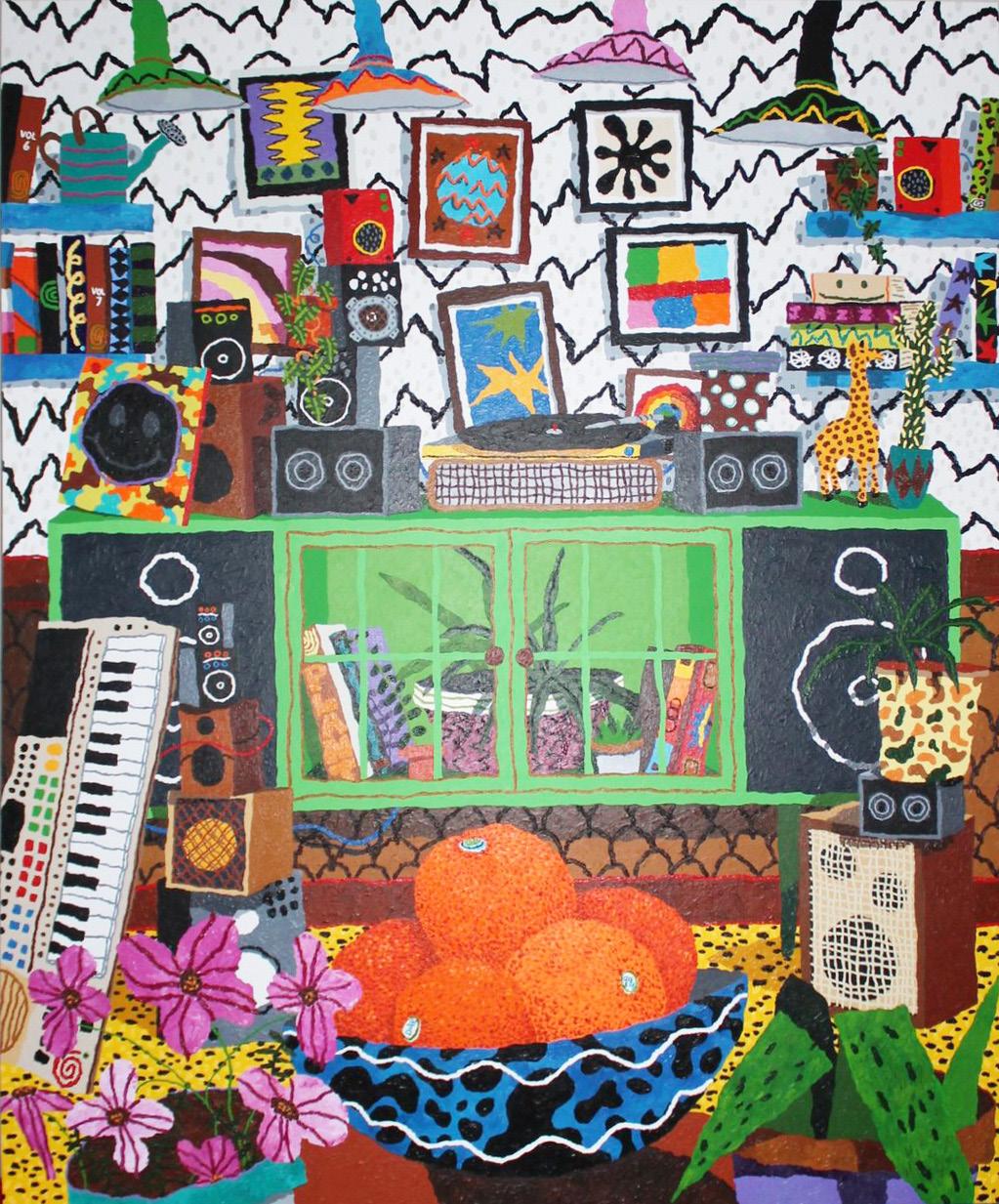
COOPER BLUE END TABLE, 2022
Acrylic on Linen 152 x 122 cm | 60 x 48 inches


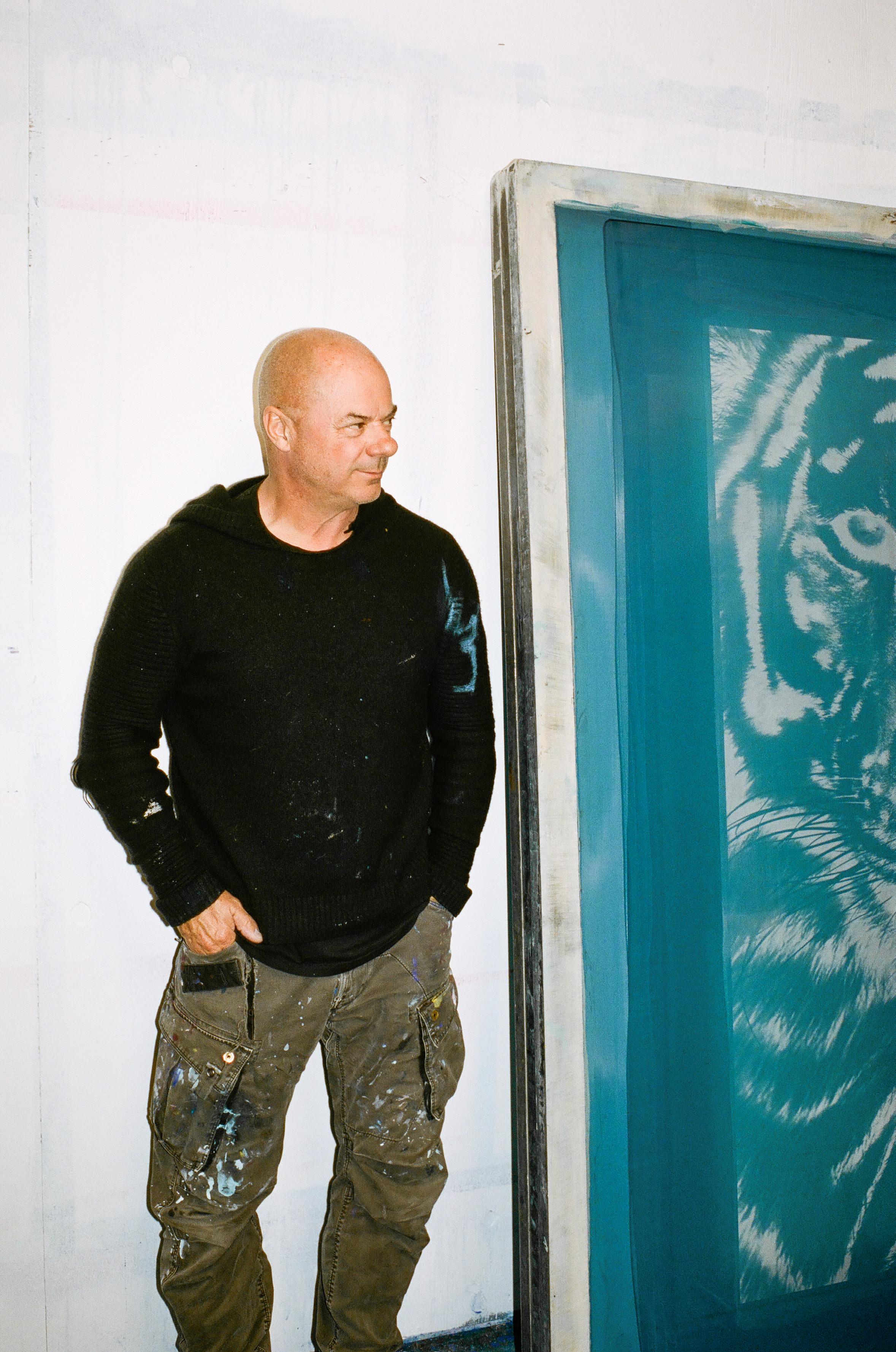
Russell Young, born in 1959 in Yorkshire, is a British-American artist best known for his large scale silk screen paintings examining cultural icons, the nature of fame, and the souring of the American Dream.
His earliest breakthrough was his photography of George Michael for the sleeve of the album Faith in 1987. Young photographed many music stars throughout the 1970s and 1980s, including Morrissey, Bruce Springsteen, Bob Dylan, REM, The Smiths, Bauhaus, Diana Ross, Paul Newman, Björk, and many others.
He went on to shoot over 100 music videos for leading artists during MTV’s height in the 1990s, which brought him to the United States.
Young eventually moved to California, where he began his current practice with his sold-out show Pig Portraits in Los Angeles in 2003. The many series that have followed, including his ongoing Heroes + Heroines and WEST, demonstrate his visceral, analog processes and signature use of diamond dust. He has exhibited across the world in numerous galleries alongside masterclass artists, institutions, and cultural figures. These include museum exhibitions at the Modern Art Museum Shanghai, Multimedia Art Museum Moscow, Cornell Art Museum, Polk Museum of Art, and the Goss-Michael Foundation. His genesis NFT debuted and sold on SuperRare in 2022.
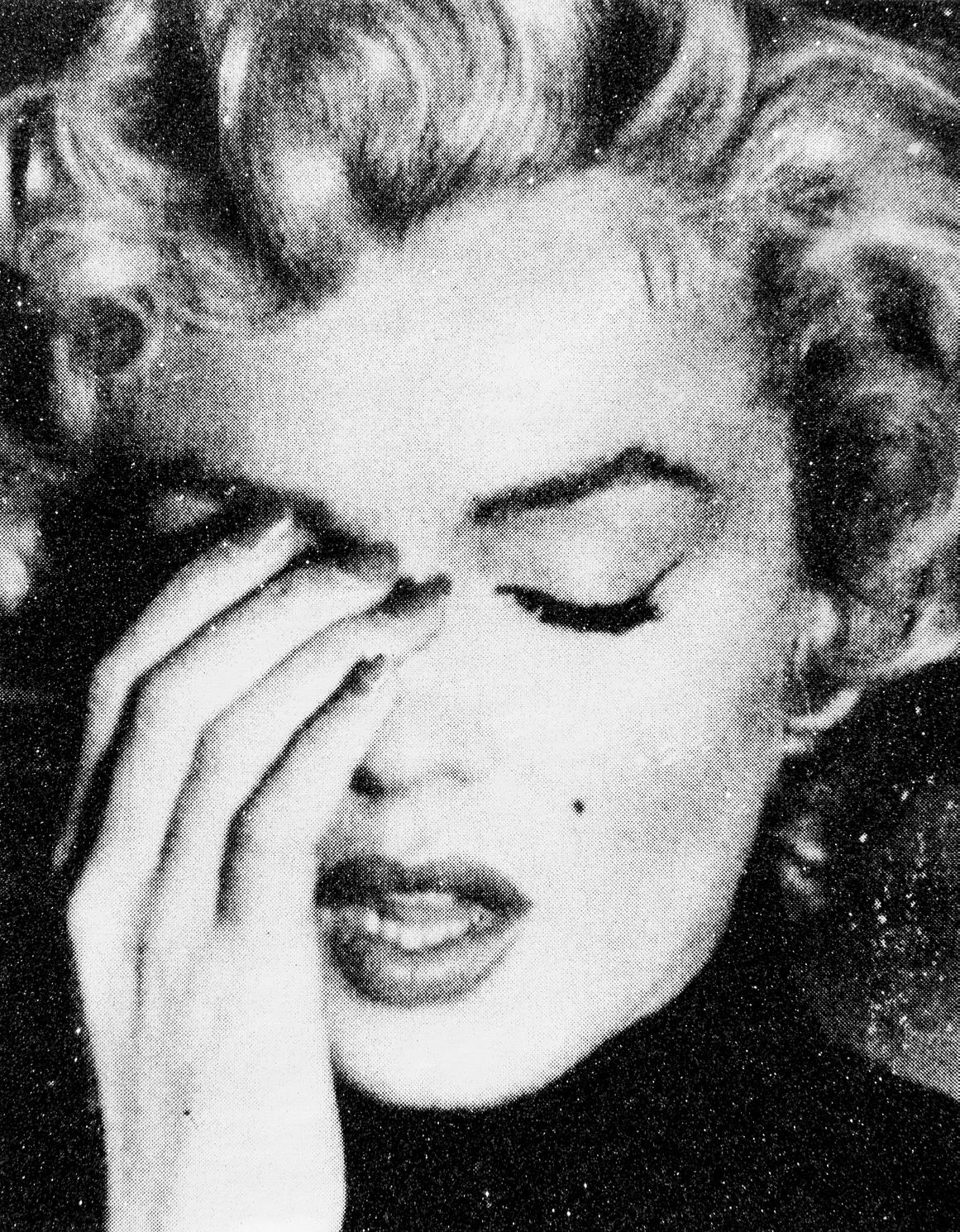









Hand Pulled Acrylic, Enamel Screen Print and Diamond Dust on Linen 188 x 145 cm | 74 x 57 inches

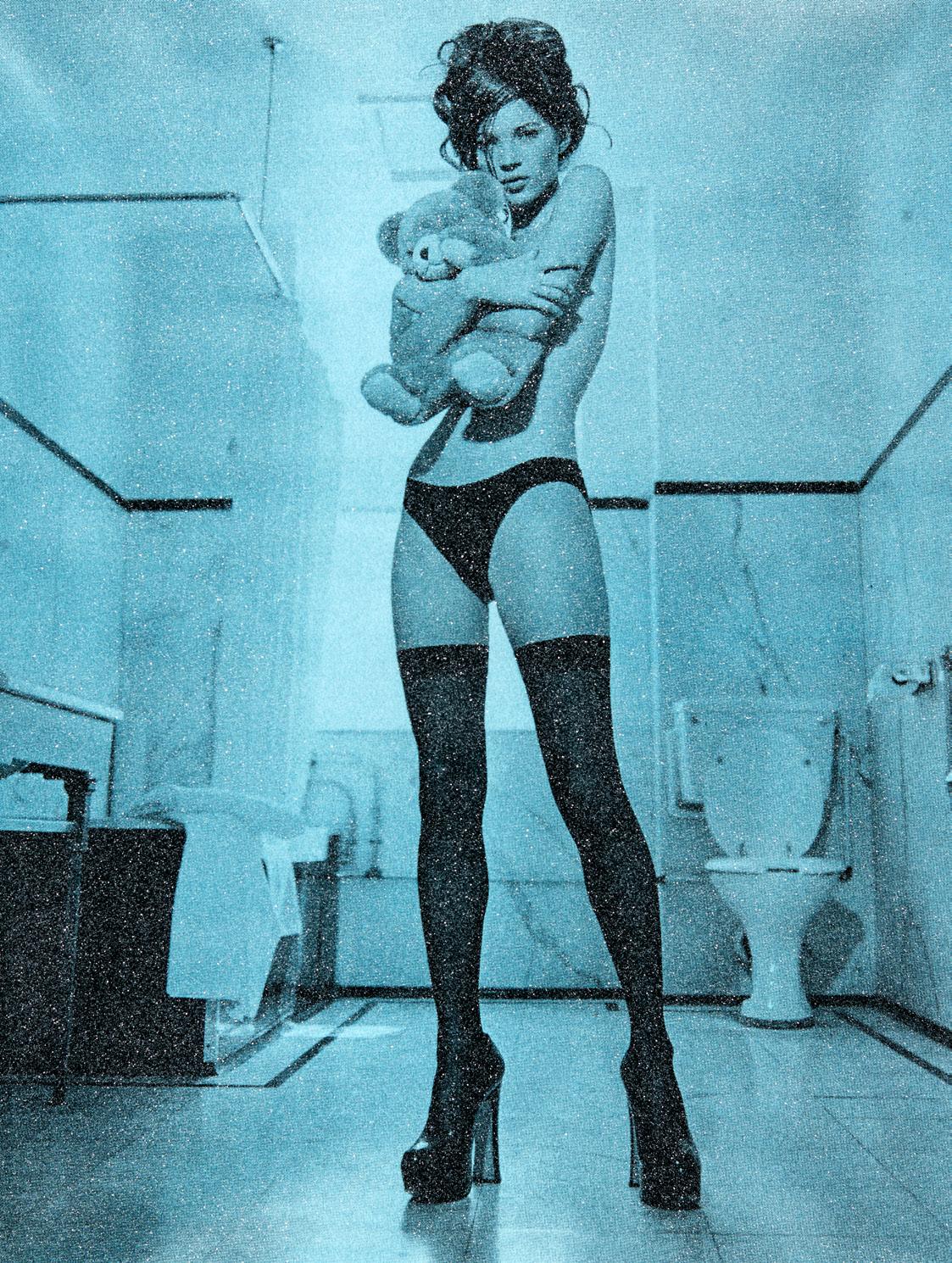
Acrylic Paint and Enamel Screen Print with Diamond Dust on Linen 165 x 127 cm | 65 x 50 inches


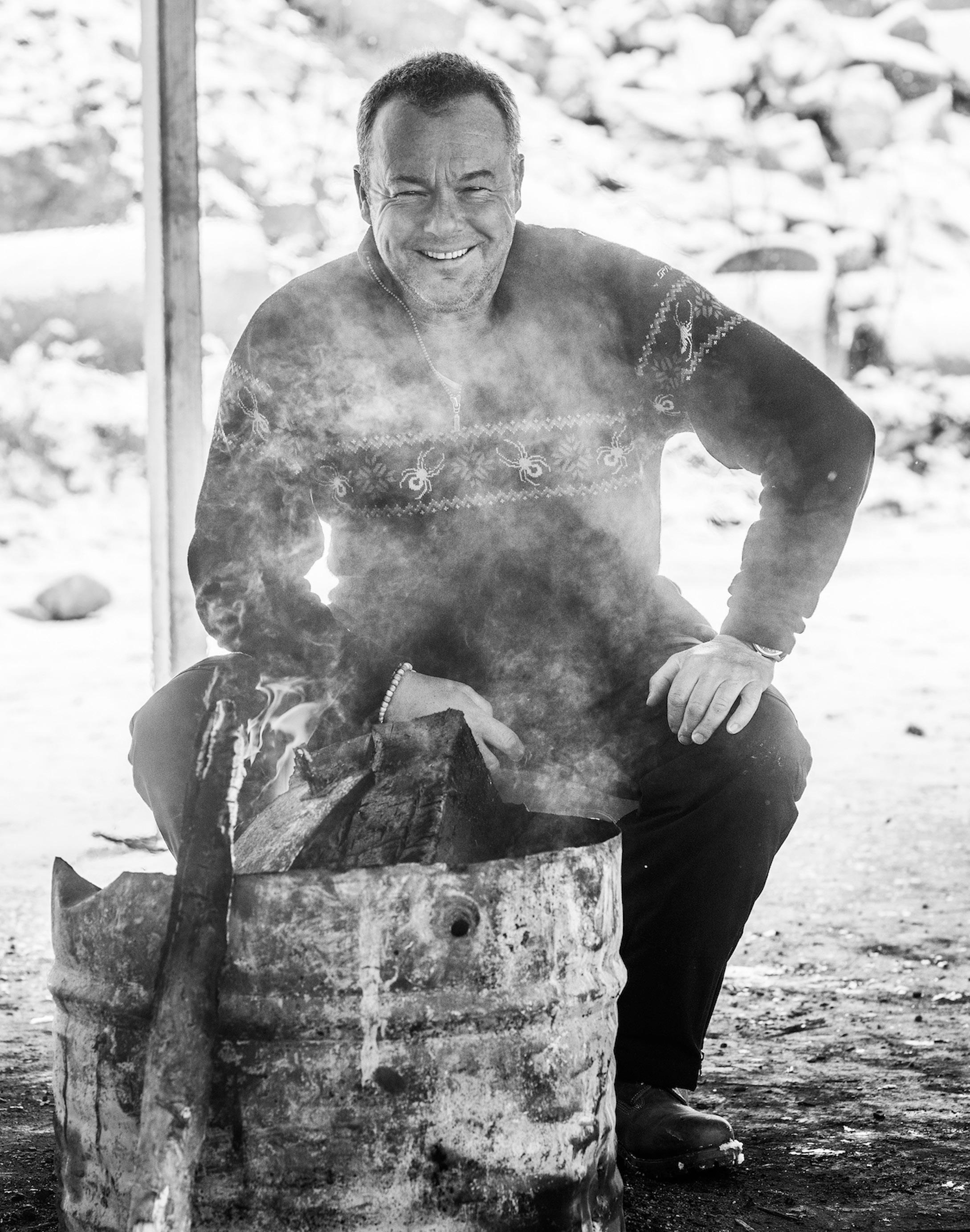
“I don’t think I’ve ever taken a picture before in which the subject is less than one per cent of the image and yet everyone’s eye is immediately grabbed by that one point. That was always my intention”.
Yarrow was born in Glasgow in 1966 and started his photography career working for the London Times at the age of 20, taking pictures of the World Cup Final in Mexico City. He famously photographed Diego Maradona holding the World Cup which propelled the photographer to stardom. After graduating from Edinburgh university, Yarrow pursued a career in finance and continued producing photography at the same time.
Yarrow is most famous for his visceral, powerful photography of life on earth, specifically wildlife. He cites the photojournalism of Robert Capa as a major inspiration for his work and has produced printed photographs of the elephants and lions of the African savannahs to the penguin colonies of Antarctica. His signature style is high resolution, black and white photographs with a focus on shadows and heavy saturation, resulting in an evocative and dramatic effect.

Archival Pigment Print
180 x 226 cm | 71 x 89 inches Edition of 12
 DAVID YARROW
DAVID YARROW


Archival Pigment Print
170 x 292 cm | 67 x 115 inches Edition of 12

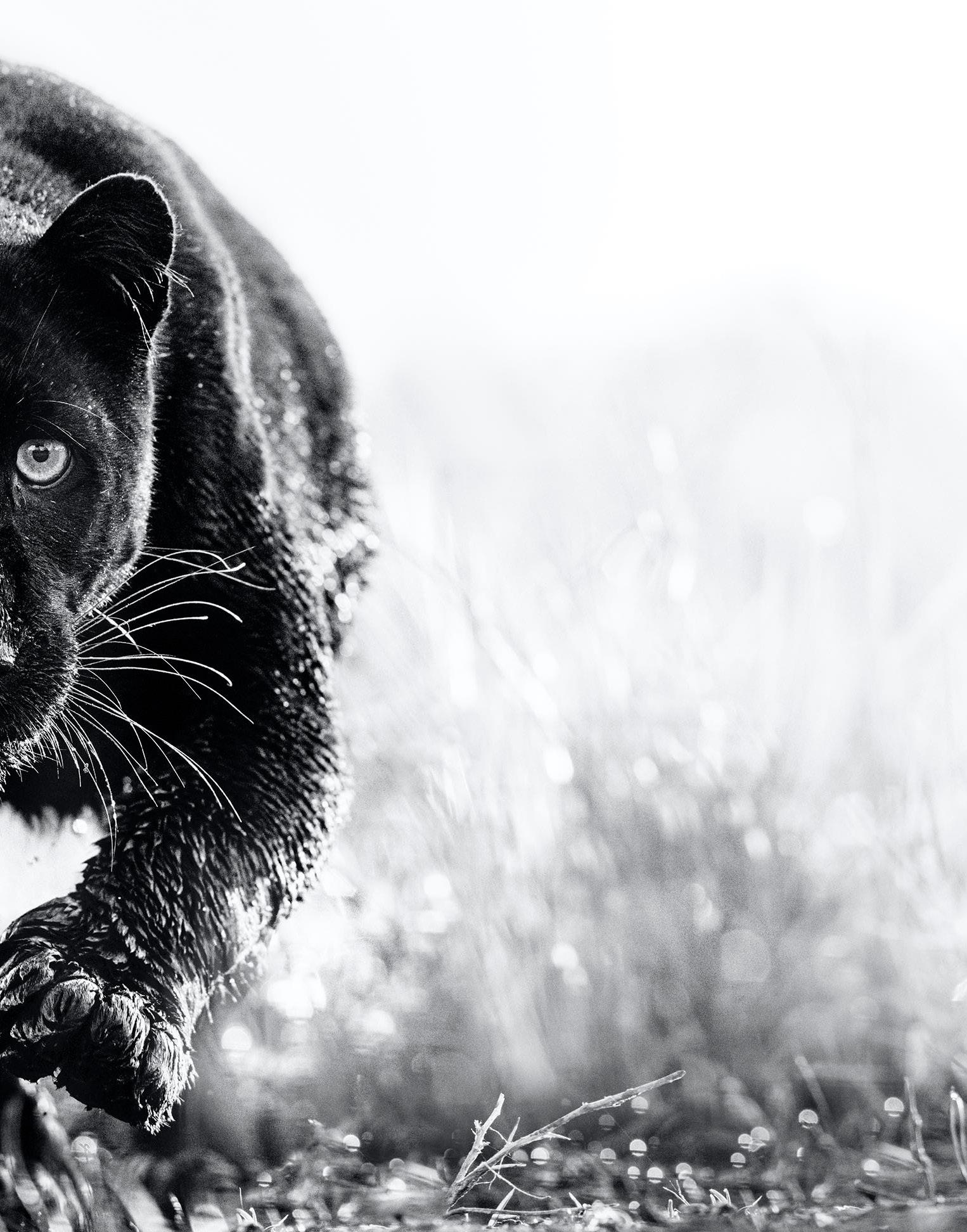







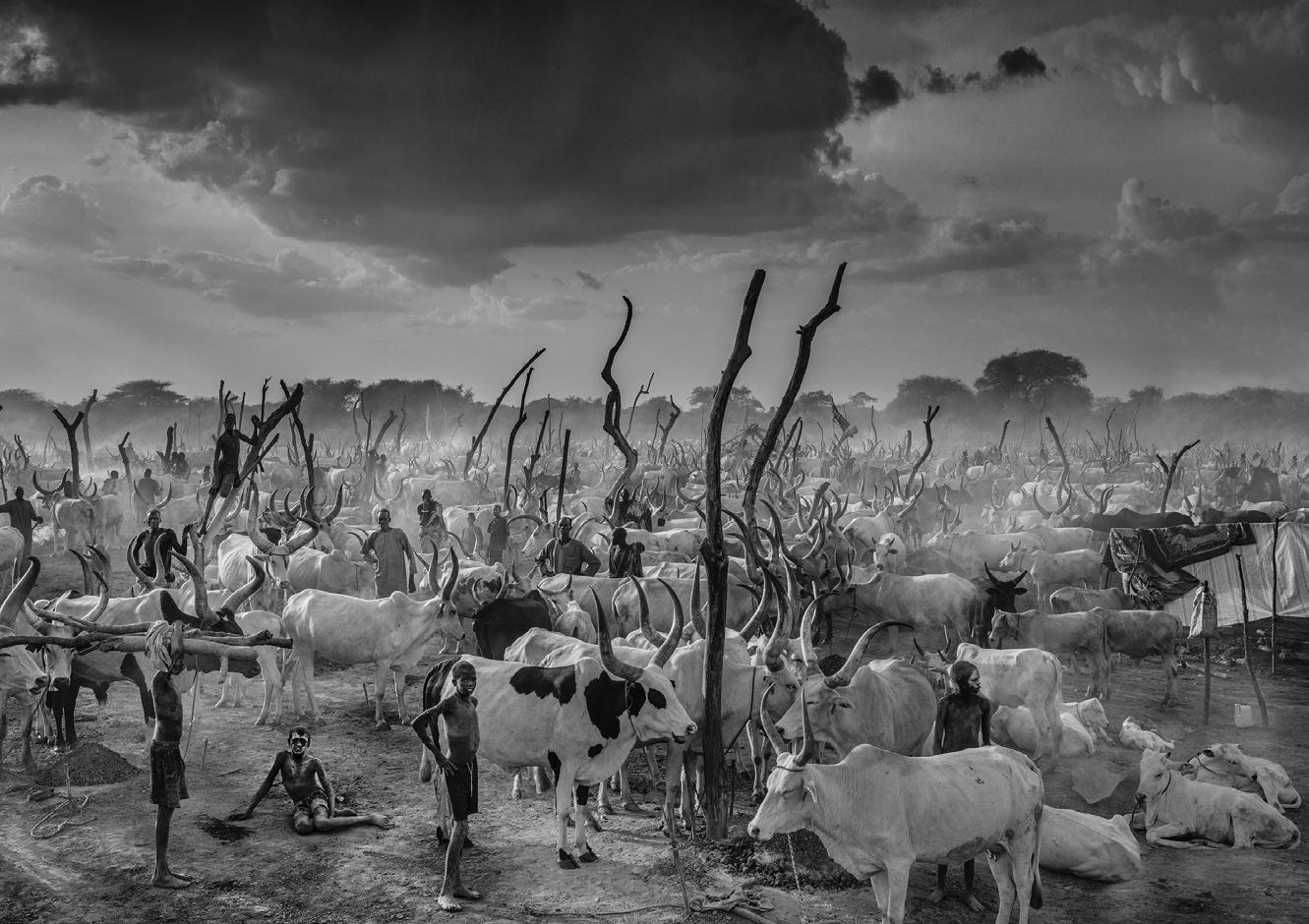





Archival Pigment Print 180 cm x 216 cm | 71 x 85 inches


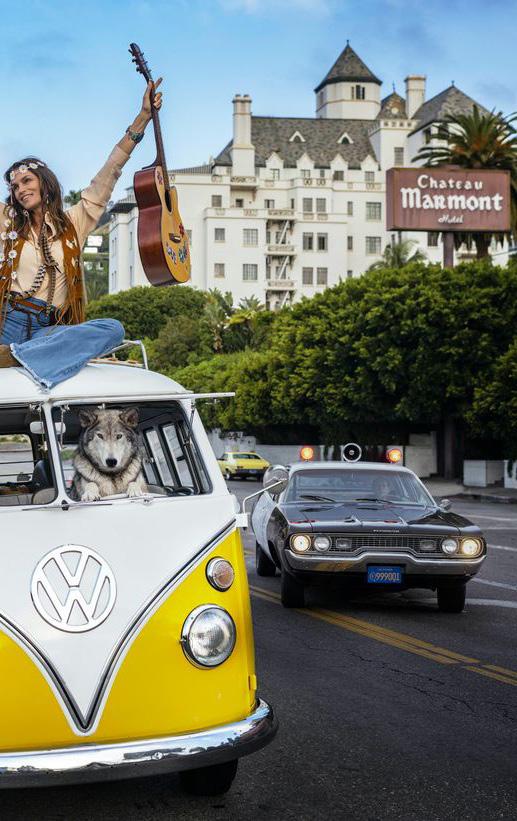

“It is the paradox of art, that artifice is often the best way to depict reality”.
The Connor Brothers is the pseudonym for British artists James Golding and Mike Snelle. The duo came to prominence in 2012 and for several years maintained their anonymity by using a fictional biography. Their identities were revealed in 2014 in a major feature by Mick Brown in The Telegraph magazine, allowing them to undertake more ambitious projects.
Best known for their Pulp Fiction series, the pair are also known for their activist work and their playful hoaxes. In 2014 they created a fictional museum -The Hanbury Collection, which fused truth and fiction in such a way as to render it impossible to work out which exhibits were real and which were not. This obsession with truth and fiction can be seen throughout their work, and is particularly relevant in the current climate of fake news, post-truth, and social media obsession.
The Connor Brothers have been amongst the most prominent artistic voices to comment on the refugee crisis. The duo worked for several years in The Jungle refugee camp in Calais building shelters and undertook an international billboard campaign highlighting the plight of displaced peopleRefuchic. Closely associated with the Russian activist group Pussy Riot, The Connor Brothers produced their 2015 refugee themed theatrical performance at Banksy’s Dismaland. More recently they have teamed up with Professor Green and the mental health charity CALM to raise funds and awareness about the UK’s epidemic of male depression and suicide.
The Connor Brothers have exhibited internationally from New York, Sydney and Dubai to London, Hong Kong and Berlin. Their work frequently appears at major auction houses where a record price was achieved in 2020. Works can also be found in major public and private collections including The Victoria and Albert Museum, The Penguin Collection and both the Omer Koc and Niarchos Collections.


Acrylic and Oil Stick on Canvas 145 x 225 x 6 cm | 57 x 89 x 2 inches




THE CONNOR BROTHERS DEVIANT, 2022
Acrylic and Oil Stick on Canvas 225 x 145 x 6 cm | 89 x 57 x 2 inches

THE CONNOR BROTHERS MISCREANT, 2022
Crayon on Paper 38 x 28 x 3 cm | 15 x 11 x 1 inches


Crayon on Paper 28 x 38 x 3 cm | 11 x 15 x 1 inches





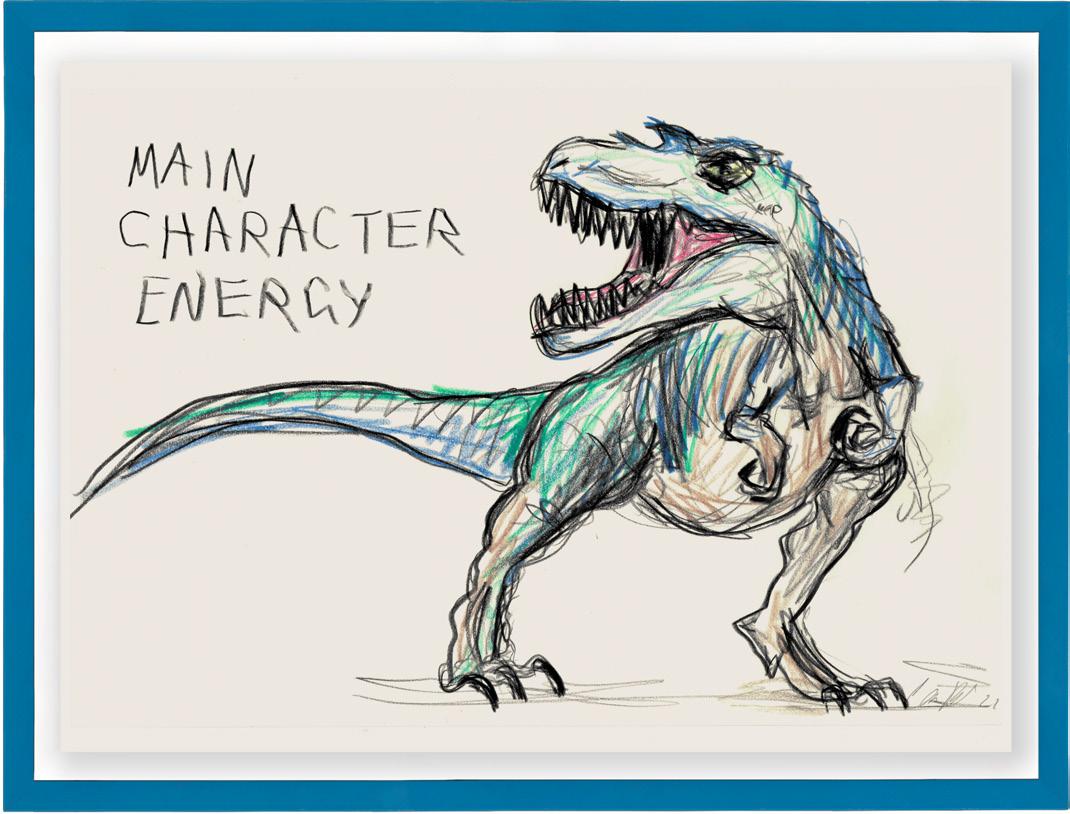



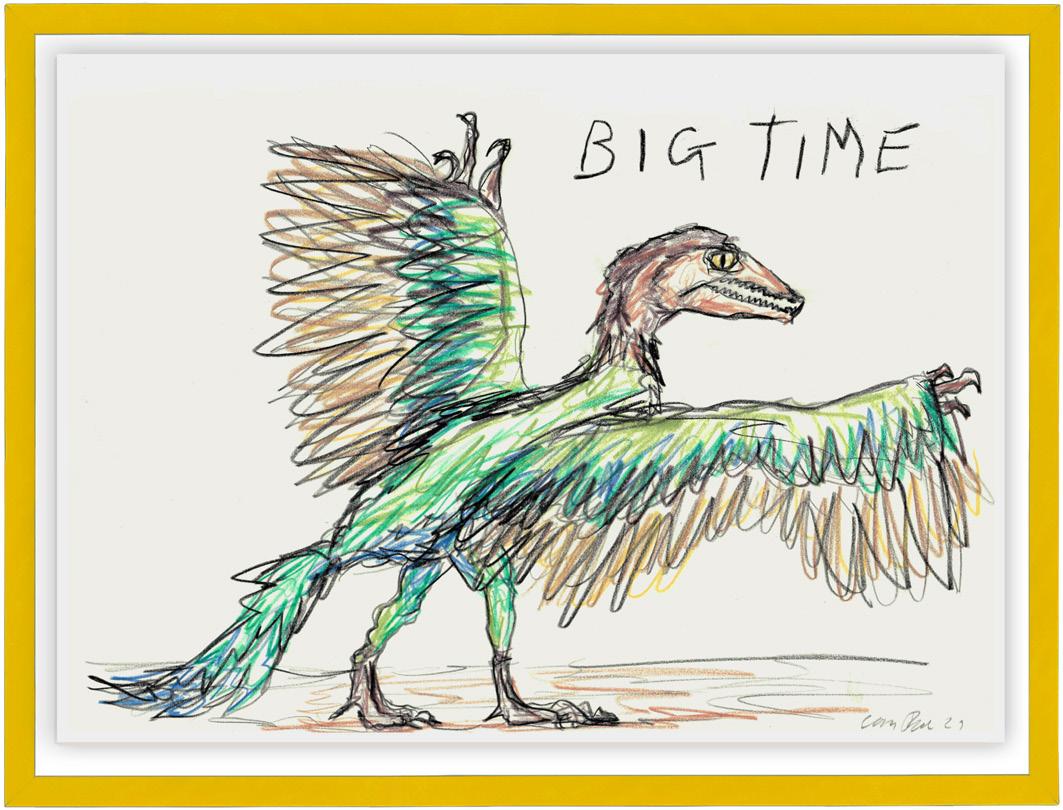




THE CONNOR BROTHERS BIG TIME, 2022
Crayon on Paper 28 x 38 x 3 cm | 11 x 15 x 1 inches




“We look to provide a visual experience that compels the viewer to recognise and re-establish the limits of his or her own perception”.
Born in 1965 and 1968 respectively, the two brothers Renato and Roberto were raised in Milan, Italy. Both siblings were close from a young age, exploring artistic processes and embarking on creative adventures together. The duo both proceeded to study art and European design at university and were guided by similar principles. Wishing to take a more holistic approach to their training, the Miaz Brothers modelled their education on the training of Renaissance artists, focussing on travel, philosophy and studying a diverse range of practices. Their mutual eschewal of the gallery system and harmonious relationship made their decision to become a creative duo a natural and inevitable choice for their joint progression.
Their first exhibition was in 1996 at the Viafarini Gallery in Milan. Focussing on visual interpretation and genetics, the installation not only signalled the beginning of a deep interrogation of visual perception for the artists but also marked the start of the Miaz Brothers trialling a plethora of different mediums. During this time period, the Miaz Brothers were regularly operating in unconventional venues alongside their gallery shows. Nightclubs and music events offered a more experimental approach to their practice and presented a diverse audience, allowing the brothers to hone their artistic skills whilst exploring new digital innovations.
MIAZ BROTHERS ROYAL BLUE, 2022
Acrylic on Canvas
152 x 122 cm | 60 x 48 inches



Jack Kabangu was born in 1996 in Zambia with roots in DR Congo and has lived in Denmark since 2005. He is based in Copenhagen, where he lives and works in his studio. Jack is a self-taught visual artist. Expressing himself artistically has always been his special language. His artistic universe contains cultural roots. The African roots merge with the Danish in a very special expression that goes beyond the verbal. Characteristic for his paintings is the gloomy figures and mix of colors. The starting point for him is to find a connection between the dark and the light, the ugly and the beauty. In his artistic work, Jack places great emphasis on seeing the artistic context that for him moves beyond just the work of art itself. For Jack, the artwork is completed once it has found its final surroundings.







Mixed Media on Canvas (Acrylic, Oil, Oil Stick, Oil Pastel, Sand and Paper). Oak Framed. 180 x 130 cm | 71 x 51 inches

 JACK KABANGU
JACK KABANGU
Mixed Media on Canvas (Acrylic, Oil, Oil Stick, Oil Pastel, Sand and Paper). Oak Framed. 180 x 130 cm | 71 x 51 inches



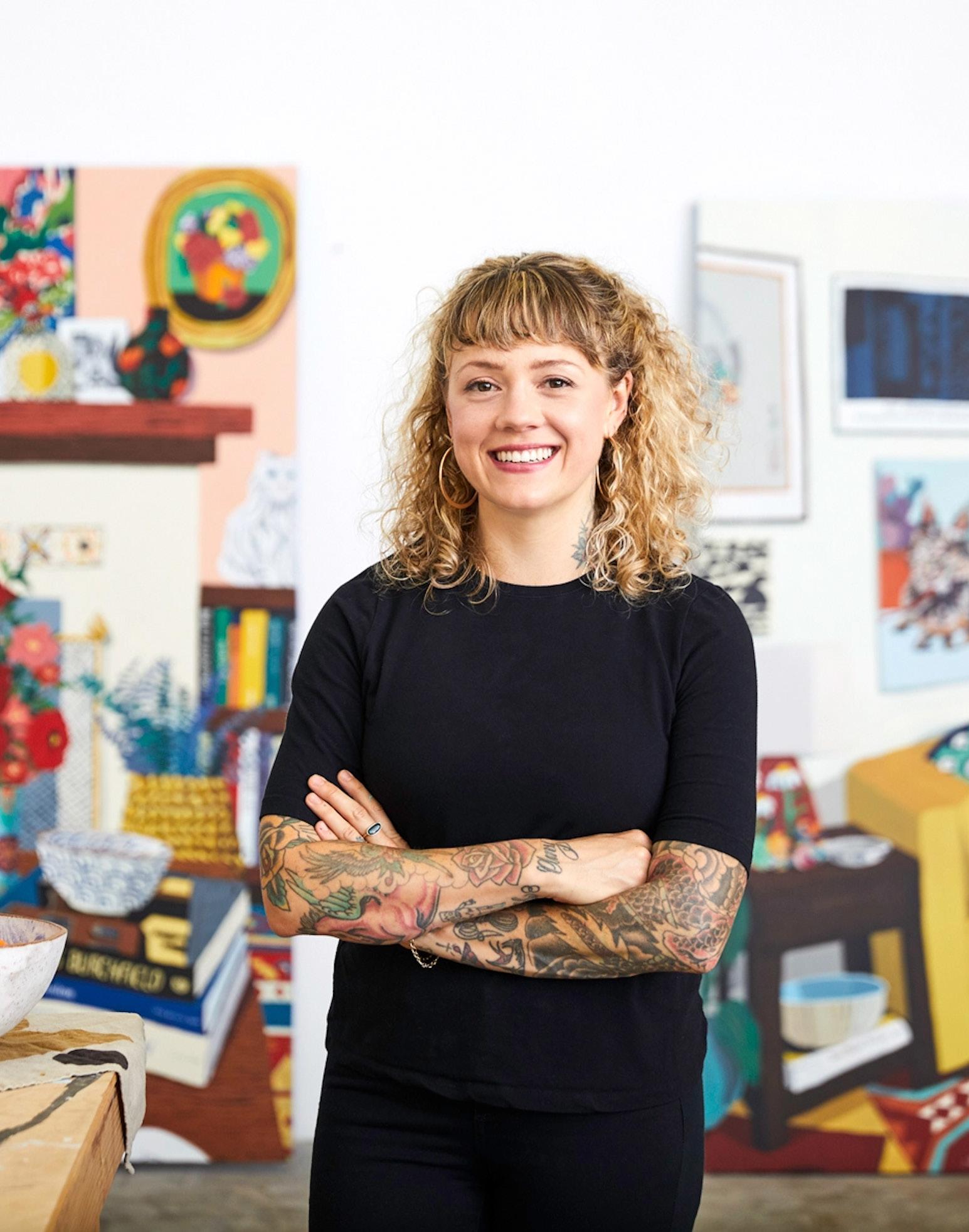
Hilary Pecis (b. 1979, Fullerton, California) makes paintings and drawings in which tableaus rich with interlocking fields of saturated color, geometric patterning, and bold linework provide views of sun-drenched domestic still lifes and landscape environments. Books crowding a coffee table, the remains of a dinner party, and terrains lush with Southern California succulents make frequent appearances in her work; these meticulously arranged interiors and vibrantly rendered exteriors amount to an overarching portrait of the self that identifies objects and locations as signifiers for human characteristics. Pecis combines distorted perspectives and surprising juxtapositions of hue, placing her work in dialogue with modernist art historical movements like Fauvism in which subjective and analytical tendencies are synthesized. At the same time, her interest in images sourced from her personal experience allows her to transform recognizable mise-en-scènes into vivid explorations that celebrate the quiet moments of everyday life.


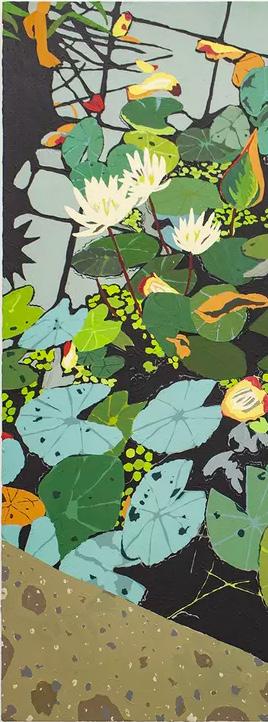


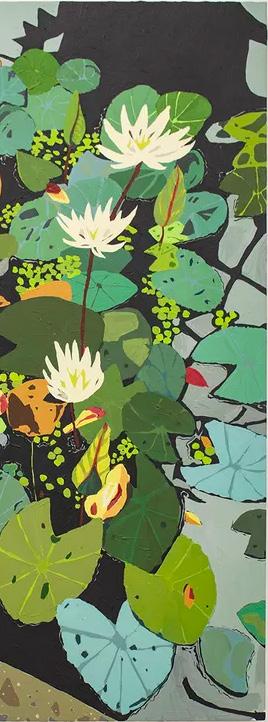



“They are born from a fantastic, surreal and expressionist figuration. I consider them hybrid characters closely related to my admiration for Dubuffet, Bonifacio, and Alfonso Fraile.“ Rafa Macarrón paints abstract figures in daily acts of tender comedy. A former physiotherapist, he uses his anatomical knowledge to create exaggerated body shapes. Their giant, cubist hands and feet disrupt perspective and float in unstructured space. Some paintings show stark singular portraits. Others show colourful crowded panoramas – with figures congregating at bus stops or beaches. Macarrón’s process is led by intuition and experimentation with a range of materials. Acrylic, gouache and oils are the main base. Pencils and markers define figures. Aerosol sprays, aluminium and PVC bring texture and dynamism. The artist also translates his biomorpic personalities into drawing and sculpture.
Macarrón is “very proud to be part of the Spanish painting tradition.” He’s inspired by artists who explore tensions between format, scale and colour. In particular, Joan Miro and the El Paso Madrid group. He also references the French painter Jean Dubuffet, New Figuration and Abstract Expressionism. Together, these rich legacies evolve further in Macarrón’s work. Through the bright remix of materials and style, he refreshes and builds on the past. As the artist puts it himself: “these canvases are about rebirth, they speak of a new hope of life.”
Mixed Technique on Aluminium 226 x 146 cm | 89 x 58 inches

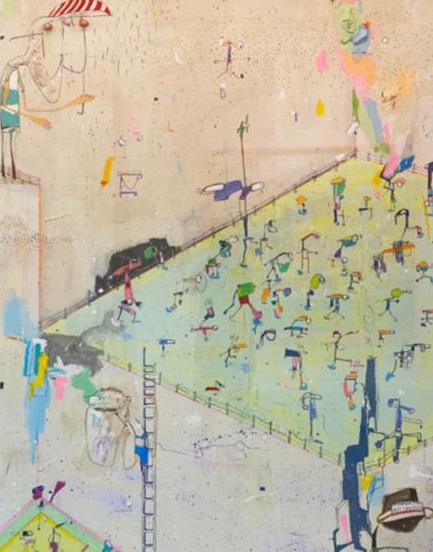

Javier Calleja was born in 1971 in Malaga where he lives and works. Over the years Calleja worked with drawings, installations, sculptures, and paintings, often playing with the scale and perspective in his presentations. Working both in minuscule and large scale his installations were regularly focusing on beguiling the viewer as a significant part of the work.
After showing around Spain and the rest of Europe, it was his debut with Aisho Nanzuka in Hong Kong that for the first time debuted on his big-eyed boy characters. Originally imagined as visual representations of the artist’s own feelings and experiences, they became his unmistakable signature. Over the years the characters evolved from drawings, over paintings, into sculptures and objects, almost exclusively depicting a boy in the transitional age between the childhood and adolescence. With oversized, watery eyes, and subtle addition of red blush, Calleja’s characters are little heroes who just overcame something painful and are about to smile again after crying.
“Every character is like my son. At the end of my life, I might have thousands of children.”






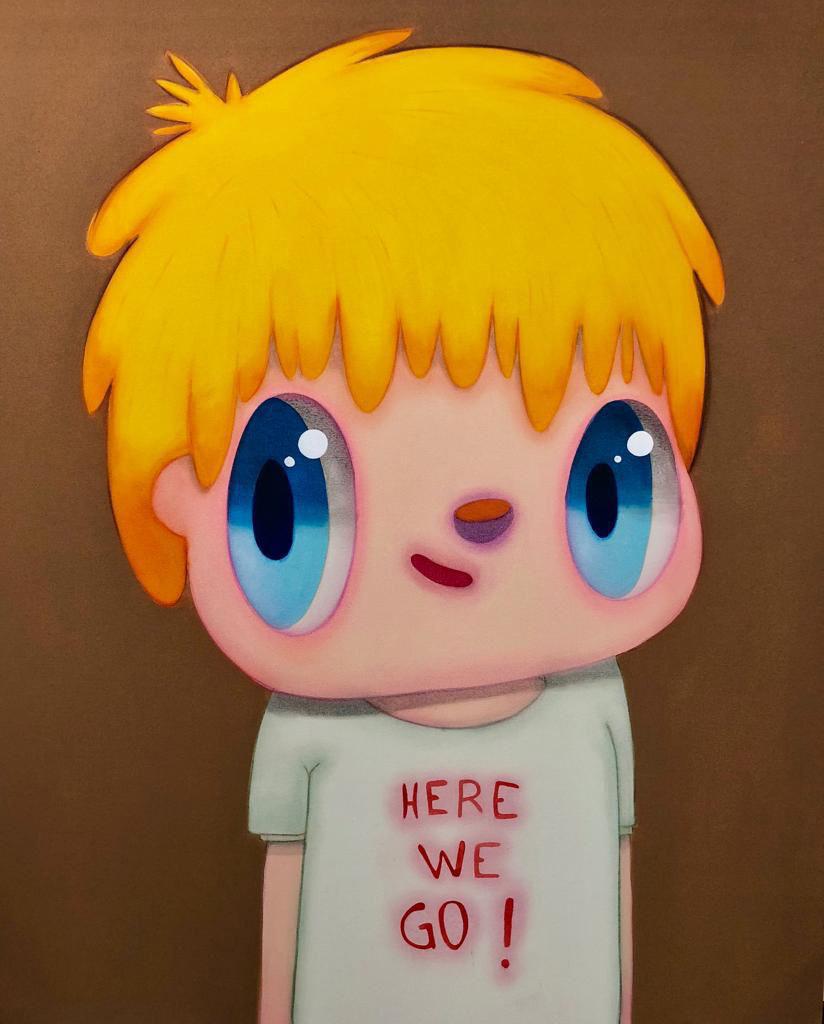


Erik Parker’s vivid, hallucinatory paintings combine elements of traditional portraiture and landscapes with the aesthetics of psychedelia, comic books, and graffiti art. The artist depicts neon-drenched scenes that feature flowers, waves, and distorted faces. Early in his career, Parker painted dreamlike flourishes and patterns composed of pointillist dots, teardrops, and paisleys. He has exhibited in New York, Tokyo, Paris, Hong Kong, Los Angeles, and Copenhagen. His work belongs in the collections of the Whitney Museum of American Art, the Brooklyn Museum, the Museum of Modern Art, the Montreal Museum of Fine Arts, the Yale University Art Gallery, the RISD Museum, and the Hammer Museum. Parker has also designed skateboard decks, created tondos (round canvases), and made long, sculptural paintings that rest on pedestals.

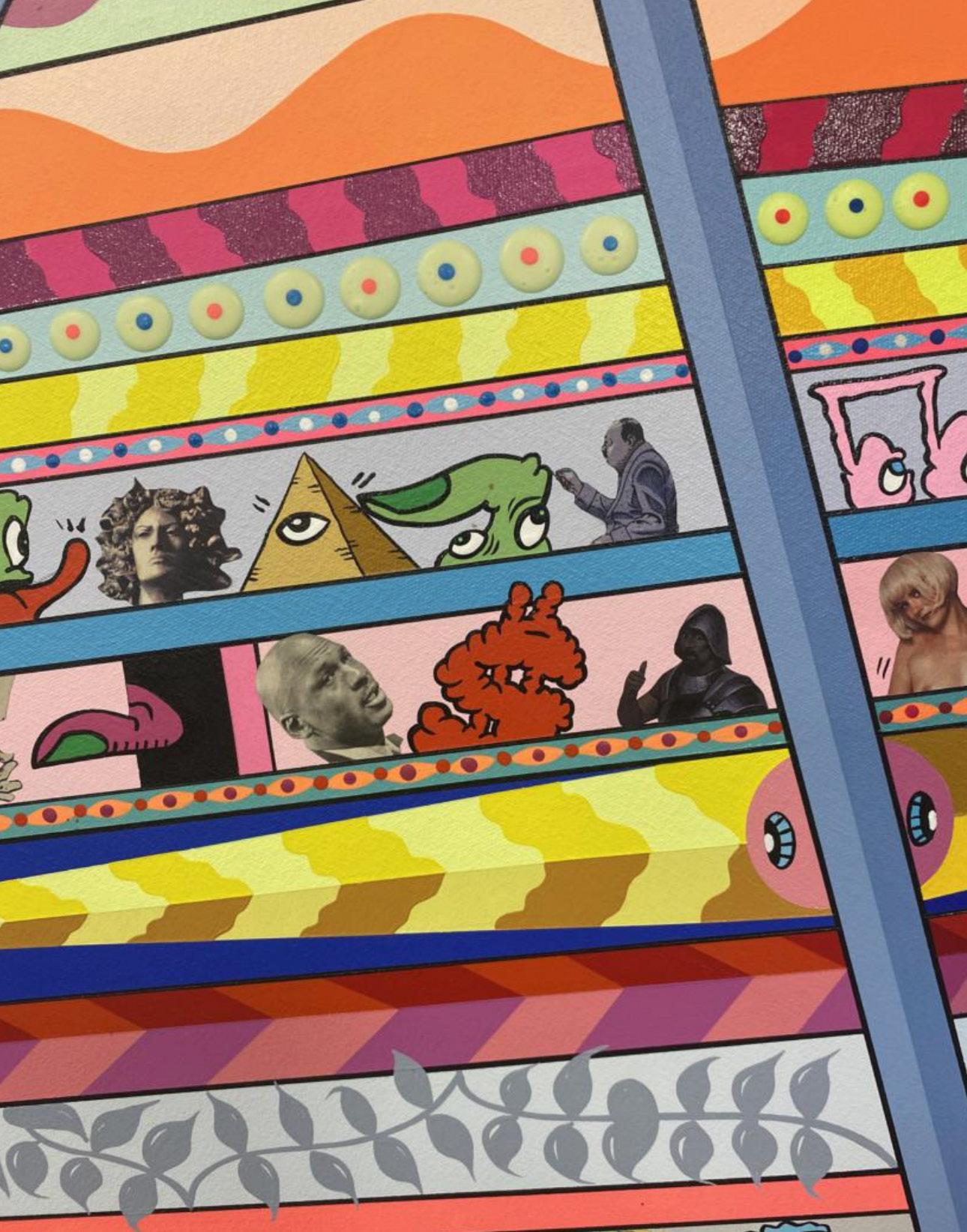

Oli Epp’s paintings circulate a number of themes to do with the tragicomic element of living in the 21st century society, dealing with the complexity of identity and anxieties living in the digital age; consumerism and consumption which leads to control and addiction, anxiety and conflict. The paintings work in an endlessly cyclical way of Epp ironically questioning idealisms and our pursuit of perfection and the conflict that arises as a result. The overall aesthetic of Epp’s paintings conveys the digital world; mimicking the screen, toying with the physicality of surface.









The figurative painter Ania Hobson creates celebratory portraits of millennial women. Her work has been exhibited throughout the UK and Italy and was featured in an exhibition at the 2019 Venice Biennale. In 2018 she received the Young Artist Award at the National Portrait Gallery’s BP Portrait Awards in recognition of her painting A Portrait of Two Female Painters (2018). Drawing inspiration from both Alice Neel and Kerry James Marshall, Hobson’s oil paintings feature friends and peers rendered in thick impasto. Her female subjects are shown as strong and unworried as they chat among friends or glance thoughtfully from beyond the frame. She often presents her figures from high or low vantage points, which bestows them with imposing, monumental presences. Fashion also plays a major role in her work through deliberate sartorial details, such as the inclusion of recognizable brand motifs like Burberry plaid.
CAUGHT, 2021
Acrylic & Oil on Canvas 160 x 195 cm | 63 x 77 inches

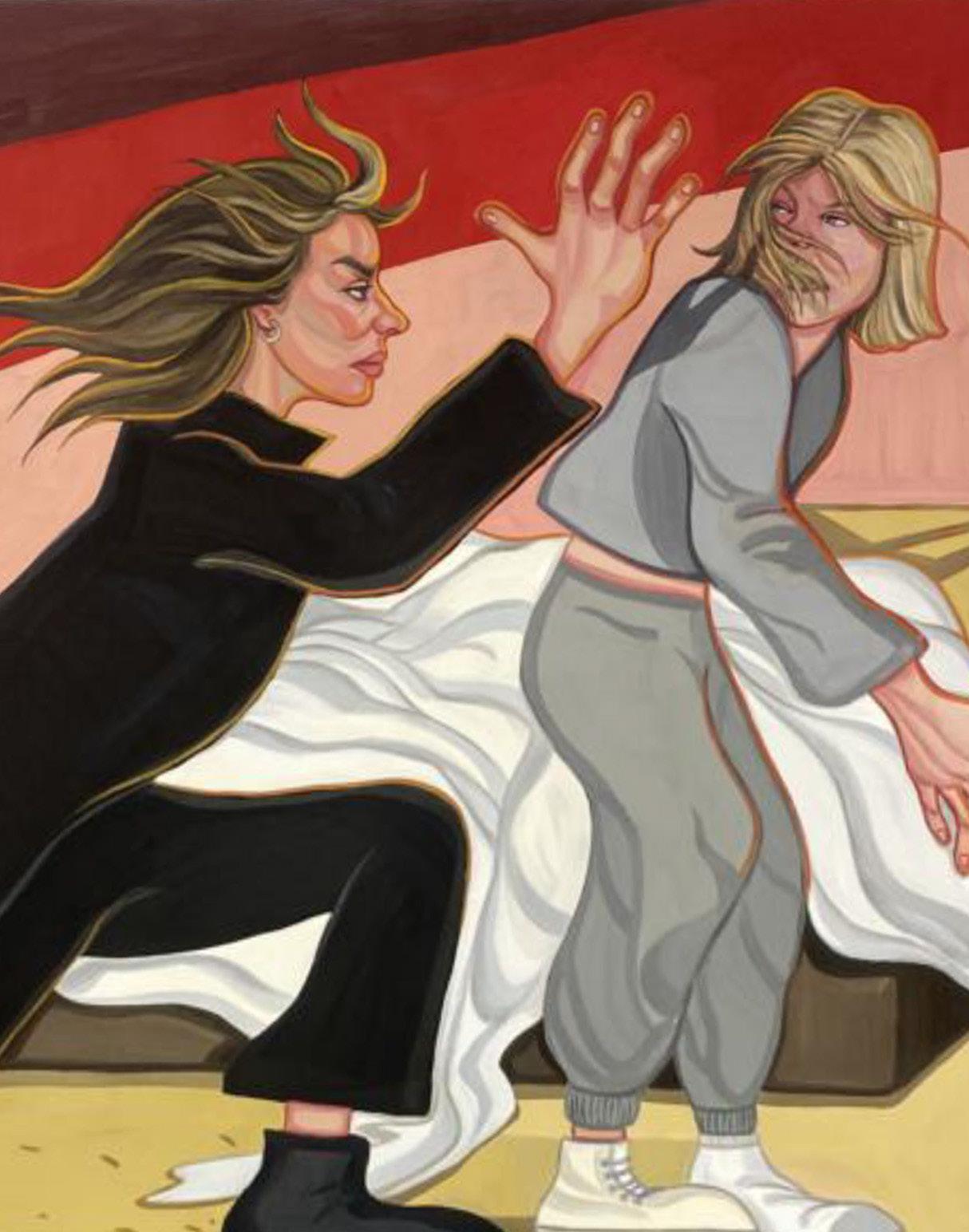

“These poolside compositions are designed to be familiar and safe, reminding the viewer of places they have loved and laughed”.
Will Martyr was born in Eastbourne in the United Kingdom in 1980. At the age of 18, he was accepted into the prestigious Slade School of Fine Art in London. During his time at The Slade, the artist experimented with colour, drawing on influences from Ellsworth Kelly, Josef Albers and Richard Diebenkorn. Martyr calls himself a colourist to this day.
Following his time at The Slade, Martyr moved to New York to live and work. The city inspired him with its diverse and rich art scene and its juxtaposition of architectural genres and scale. This fed into Martyr’s early architectural paintings. Martyr returned to London in 2005 to complete his education at the Royal College of Art. He still lives and works in London today.
Martyr’s illustrious education has had a profound effect on his practice. From the unconventional shape of his circular canvases, named tondos, to the hard-edged qualities of his painting, reminiscent of Pop-Art, Modernism and Italian Futurism, his artwork is heavily influenced by the history of art. Over the years, Will Martyr’s subject matter has largely been urban and natural landscapes: windows into utopian environments, fragments of interiors and narrative cut-outs. However,recently, the artist has introduced a human figure in his compositions. His wife has been his latest muse in the creation of his alluring paintings which bear titles such as “Something Special”, “Dancing across the water” or “Wherever you are its alright”.
WILL MARTYR TIME WITH YOU, 2022
Acrylic on Canvas 200 x 150 cm | 79 x 59 inches

WILL MARTYR SHE CHOSE ME, 2022
Acrylic on Canvas 200 x 150 cm | 79 x 59 inches
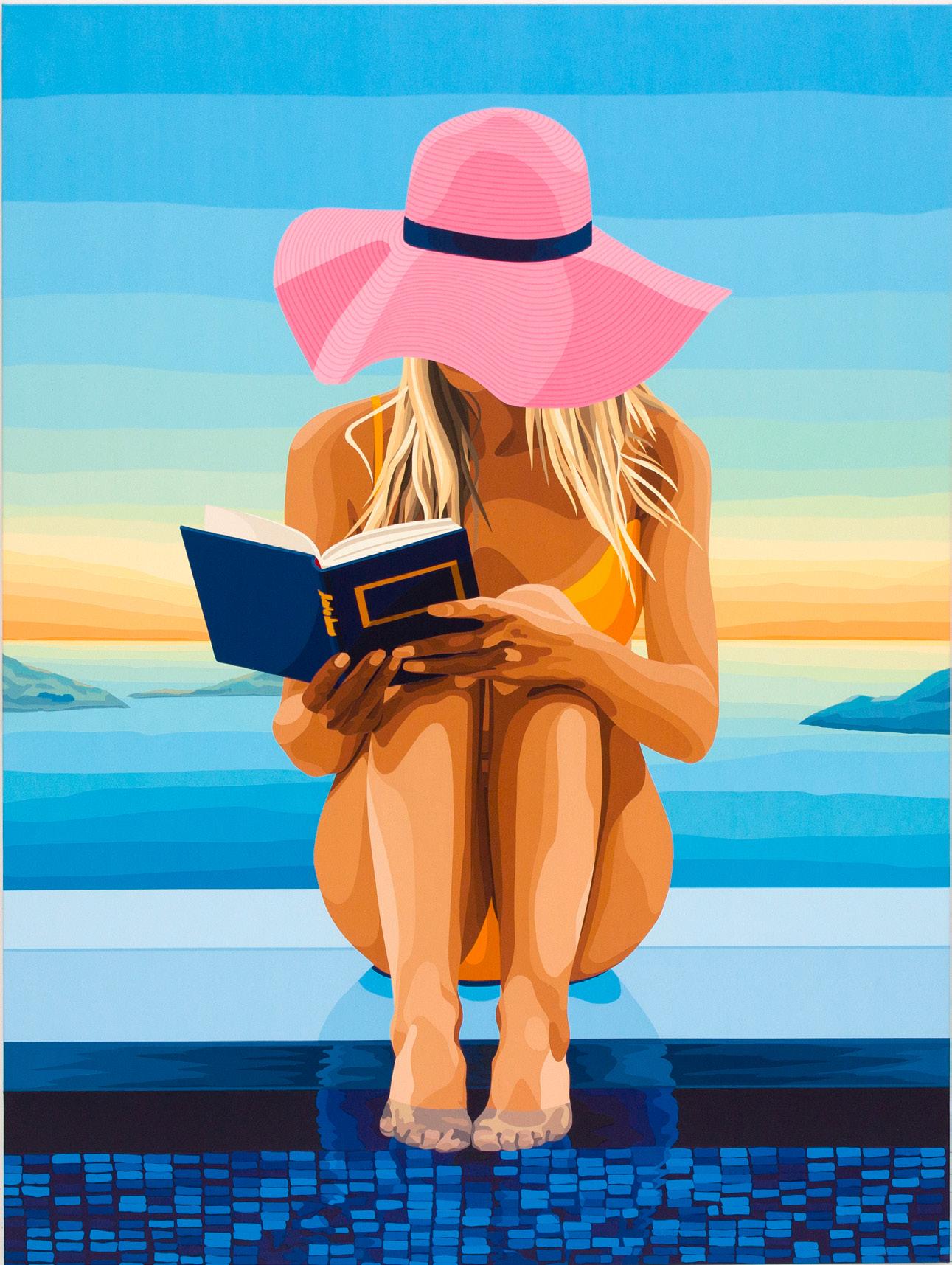



Since 2016, Lefty has worked in various different digital mediums beginning with VJing and progressing into large-scale projection mapping events and partnerships.
By creating intuitive, repeated shapes, Lefty Out There achieves the rare feat of working in contradictions. His work is both bold and intricate. Organic but uniform. A simple mark makes up a considerably more complex whole.
Lefty’s work was born on Chicago’s walls but has gained recognition by fine art galleries, interior designers, fashion brands and the digital realm. His signature squiggles and marks are now on the forefront of virtual creativity and have spanned out across Europe, the US and Asia. Following a spontaneous desire, Lefty’s pattern making makes the eye linger and yearn for interpretation –likened to cell structures and organisms, they call for the audience to pay attention to things that they take for granted.
Lefty has been refining his style for over a decade. Without any claims of connotation or secrets, Lefty’s goal is to cover the world in his art; engulfing spaces so that every single surface has been marked. His aesthetic has been adjusted throughout his projects, from working in bold block paints through to fine lines that repeat his signature pattern over and over again. He has painted murals at 60 different locations internationally. His style has sparked collaborations with the likes of Adidas, Samsung, Red Bull and many more.







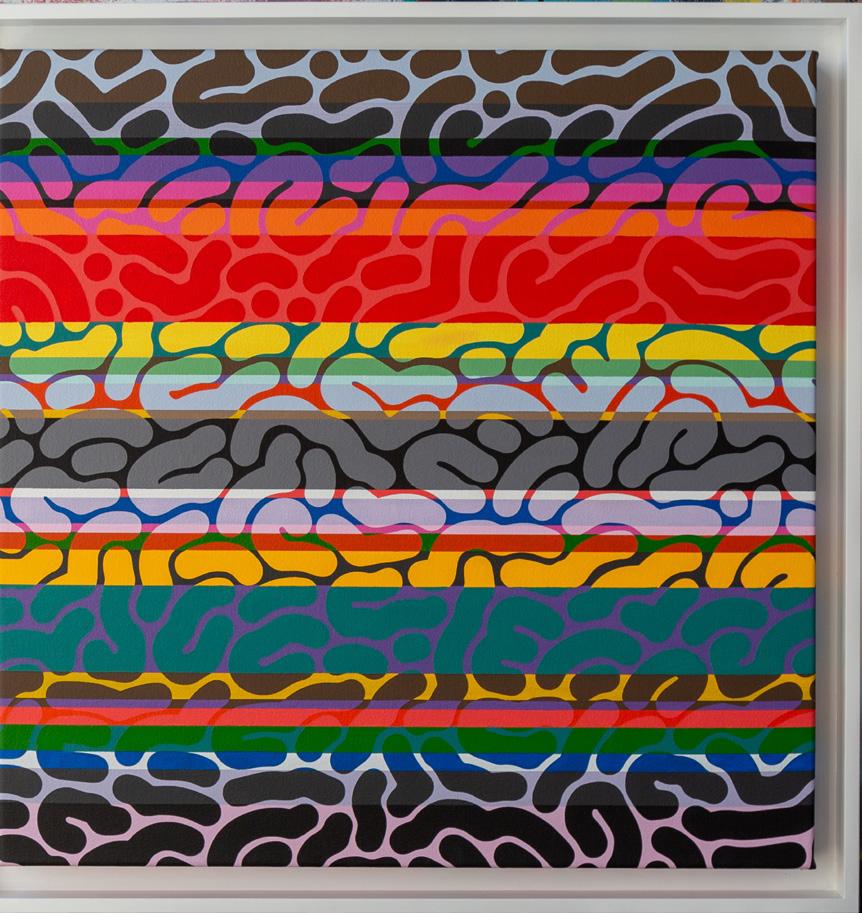




Jordan Kerwick’s gritty, thickly impastoed paintings range from haunting figurative portraits and Cubist-inflected still lifes to more abstract, gestural works in the vein of Franz Kline or Cy Twombly. The self-taught Australian artist, now based in France, began painting in 2016—more or less on a whim, he says. Kerwick quickly found himself at the center of international success: He has shown at galleries in Melbourne, London, New York, Tokyo, and Paris. Kerwick’s disparate practice embraces a range of materials including enamel, acrylic, oil, house paint, airbrush, graphite, and charcoal. The artists’ inspirations include art historical still lifes, his family, literature, music, and the city of Los Angeles.






UNTITLED, 2021
Mixed Media on Canvas
180 x 160 cm | 71 x 63 inches



“I want everyone to be happy, and happy to see my art.”
Self-taught and self-trained, the Indonesian artist Fika Arestya Sultan, better known as Fika Leon, lives and works in Yogyakarta, on the island of Java. Born in 1983, his works on raw canvas convey the beauty of the universe from a very individual perspective. Flowing like water, like an abstract painting without a title, he uses lines and colours to describe something beautiful and unusual.
Working with a wide range of materials - marker, acrylic, enamel, rubber, asphalt/bitumen and black silicone on canvas – Fika’s works explore simple and personal themes, including togetherness, family and the spirit of progress. Through abstract objects and figures, created with a deliberate use of paint colours, shapes and textures, his aim is to deliver beauty and to achieve the ultimate success in life, namely happiness.
Religion is central to Fika’s life. “With each new work I am trying to proclaim the majesty of the Creator,” he says. A unique talent whose star is on the rise, Fika projects powerful messages through his art that we can all relate to. Art Miami is the perfect opportunity to discover Fika’s abstract, figurative interpretation of evil.
In 2018, Fika was invited to exhibit at a group exhibition organised by IndoArtNow in Jakarta, Indonesia. A flurry of exhibitions followed, with 2022 his highest-profile year to date, with exhibitions in Taiwan, Singapore, Brussels, South Korea and California. The Group Show with Maddox Gallery marks his debut at Art Miami.
FIKA LEON KIND PEOPLE #1, 2022
Acrylic, Enamel, Black and White Silicone on Canvas 145 x 145 x 4 cm | 57 x 57 x 2 inches

FIKA LEON KIND PEOPLE #2, 2022


Robert Nava was born in 1985 in East Chicago, IN. He received his BA in Fine Art from Indiana University Northwest in 2008, and his MFA in Painting from Yale University School of Art in 2011.
Known for his vibrant and mischievous approach to figuration, Nava’s creatures pulsate in electric colors within the frames of his large-scale paintings. Deceptively spontaneous, these images – heroes in battle brandishing their swords, beasts breathing fire, chariots roaring toward lightness or darkness – are developed in a rigorous process of sketching, then painstakingly committed to canvas through a variety of layered techniques calculated to subvert any sense of planning and structure. Nava’s ‘carefully done wrong’ works, executed in acrylic, grease pencil, and spray paint, are gleeful celebrations of color, line, and pop medieval references; they are likewise meticulous exercises in balance and opposition. Within the boundaries of a single painting or between multiple works spread across his studio floor, forces of rivalry and conflict erupt and dissolve not only among the depicted figures, but the modes of depiction themselves.
Nava’s distinctive visual language is highly personal. It is culled from a myriad of sources that range from ancient Sumerian, Egyptian, and Mayan art, and prehistoric cave paintings, to the powerfully symbolic mandala and such tropes of popular culture as gaming imagery and fantasy genre movies.





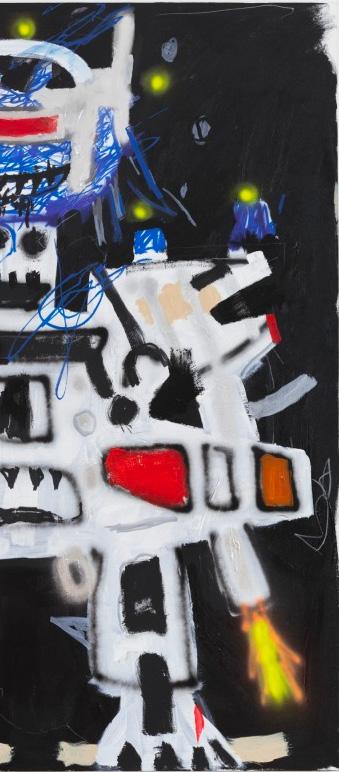
ROBERT NAVA T-LC1, 2019


